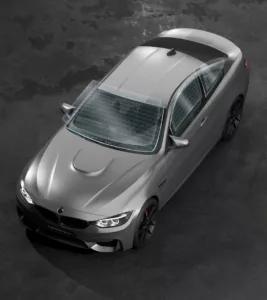How to Cover a Broken Car Window Safely | Temporary & Emergency Fixes
How to Cover a Broken Car Window Safely
A broken car window is one of those unexpected events that can happen at the worst possible time. Whether it’s due to an accident, break-in, hailstorm, or vandalism, the result is the same: your vehicle is now exposed to the elements and unsafe to drive.
If you’re wondering how to cover a broken car window temporarily, you’re in the right place. This article will walk you through safe, practical, and secure methods to seal the damage until you can get a permanent fix, along with tips on what materials to use, what to avoid, and how to handle the situation legally and financially. Also, why do we recommend TERMINAX Window Film to protect your car window?

Why It’s Important to Act Fast
When your car window breaks, you’re facing more than just an inconvenience. Leaving it exposed can result in:
- Water damage to the interior
- Theft risks
- Injury from remaining glass shards
- Legal concerns (it’s often illegal to drive with an unsecured window)
- Loss of cabin temperature control
That’s why covering the broken window promptly and properly is crucial, especially if you’re waiting for insurance processing or a repair appointment.
What You’ll Need to Cover a Broken Car Window
Before starting the covering process, gather the following items. These are commonly found in most homes or garages:
Essential Supplies:
- Heavy-duty clear plastic sheeting (e.g. trash bags, painter’s plastic, or packing film)
- Duct tape or waterproof tape
- Gloves (to protect from glass)
- Vacuum cleaner or handheld brush
- Microfiber cloth or towel
- Glass cleaner or rubbing alcohol
Optional items:
- Cardboard or foam board (for extra support)
- Scissors or a utility knife
- Hair dryer (to improve tape adhesion)
Step-by-Step: How to Cover a Broken Car Window (Safely)
Step 1: Put on Gloves and Protect Yourself
Shattered glass is extremely dangerous. Before touching anything, put on thick gloves, long sleeves, and safety goggles if available. Don’t rush this step—safety first.
Step 2: Remove Loose Glass Carefully
If the window is still partially intact, gently push out any remaining glass from the inside out. Use a vacuum or handheld brush to remove shards from the seat, floor, and door crevices. Never use your hands directly to remove glass.
Step 3: Clean the Window Frame
Once the area is clear, clean the window frame using glass cleaner or rubbing alcohol. This removes dust, oil, or residue that may prevent tape from sticking securely. Let it dry completely before moving on.
Step 4: Measure and Cut Your Covering Material
Cut a piece of clear plastic that extends at least 2 inches past the window frame on all sides. This ensures a tight seal and better weather resistance.
Tip: Use two layers of plastic for extra durability, especially if it will be exposed to wind or rain.
Step 5: Apply the Plastic Cover
Tape the plastic sheet on the inside of the window frame, starting at the top and working your way down. Pull the plastic taut to avoid flapping or sagging.
- Use long, overlapping strips of duct tape.
- Press down firmly on each strip to ensure maximum hold.
- Reinforce corners and edges with extra tape.
If you’re covering a side window, you may tape it from the outside instead, but ensure it’s weatherproof and secure.
Step 6: Check Visibility (If Driving)
For driver or front passenger side windows, temporary covers may obstruct visibility and make driving unsafe or illegal. If you must drive:
- Use clear plastic only.
- Ensure no wrinkles or folds.
- Check your mirrors carefully.
- Avoid night driving or bad weather.
When in doubt, avoid driving until the window is professionally repaired.
What NOT to Do When Covering a Broken Car Window
- Don’t use cardboard for front or side windows—it reduces visibility and absorbs water.
- Don’t leave glass inside the car—it can cause injury later.
- Don’t tape plastic directly to paint—duct tape may damage your vehicle’s finish.
- Don’t delay repairs—temporary solutions are not long-term fixes.
How Long Can You Drive with a Covered Window?
While a covered window can get you through a couple of days, it’s not a permanent solution. Most states have traffic laws that require unobstructed vision and a proper seal on all windows.
Legally, you could face a fine or citation for driving with a heavily obstructed view. Insurance companies also prefer you get repairs quickly to avoid additional damage claims.
Best practice: Use the plastic cover only until you can book a professional replacement—ideally within 1–3 days.
Pro Tip: Protect Your Vehicle with Tint or Safety Film
Once your new window is installed, consider adding window tint or safety film. These can:
- Strengthen the glass
- Reduce UV damage
- Deter thieves
- Improve insulation
Brands like TERMINAX offer high-performance window tint films that not only enhance aesthetics but also add a layer of shatter-resistance—an excellent investment if you want extra protection.
Learn more at TERMINAX
Conclusion: A Broken Window Isn’t the End of the Road
Dealing with a broken car window can be stressful, but knowing how to cover it properly makes a big difference. By following the steps above, you can protect your car’s interior, stay safe, and avoid further damage until it’s professionally repaired.
If you want to minimise the chances of future glass damage, consider investing in automotive window film like that from TERMINAX—they offer style, privacy, and extra safety all in one layer.
FAQs
Can I use plastic wrap to cover my broken car window?
Yes, if it’s thick enough and used with strong tape. Painter’s plastic or packaging film is more durable.
Is it illegal to drive with a broken window?
Laws vary by state, but obstructed views or unsecured windows may result in fines or safety violations.


